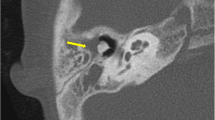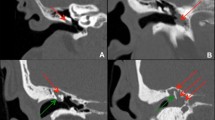Abstract
Congenital cholesteatoma is a rare, non-neoplastic lesion that causes conductive hearing loss in children. It is underrecognized and often diagnosed only when there is an established hearing deficit. In the pediatric population, hearing deficiency is particularly detrimental because it can impede speech and language development and, in turn, the social and academic well-being of affected children. Delayed diagnosis leads to advanced disease that requires more extensive surgery and a greater chance of recurrence. A need to promote awareness and recognition of this condition has been advocated by clinicians and surgeons, but no comprehensive imaging review dedicated to this entity has been performed. This review aims to discuss the diagnostic utility of high-resolution computed tomography and magnetic resonance imaging in preoperative and postoperative settings in congenital cholesteatoma. Detailed emphasis is placed on the essential preoperative computed tomography findings that facilitate individualized surgical management and prognosis in the pediatric population.
Graphical Abstract












Similar content being viewed by others
Data Availability
No datasets were generated or analysed during the current study. Radiological images in the figures are extracted from the Picture Archiving and Communicating System of three regional hospitals within Hong Kong.
References
Shekdar KV, Bilaniuk LT (2019) Imaging of pediatric hearing loss. Neuroimaging Clin N Am 29:103–115. https://doi.org/10.1016/j.nic.2018.09.011
Bovi C, Luchena A, Bivona R, Borsetto D, Creber N, Danesi G (2023) Recurrence in cholesteatoma surgery: what have we learnt and where are we going? A narrative review. Acta Otorhinolaryngol Ital 43:S48–S55. https://doi.org/10.14639/0392-100X-suppl.1-43-2023-06
Darrouzet V, Duclos JY, Portmann D, Bebear JP (2002) Congenital middle ear cholesteatomas in children: our experience in 34 cases. Otolaryngol Head Neck Surg 126:34–40. https://doi.org/10.1067/mhn.2002.121514
Kazahaya K, Potsic WP (2004) Congenital cholesteatoma. Curr Opin Otolaryngol Head Neck Surg 12:398–403. https://doi.org/10.1097/01.moo.0000136875.41630.d6
Gilberto N, Custódio S, Colaço T, Santos R, Sousa P, Escada P (2020) Middle ear congenital cholesteatoma: systematic review, meta-analysis and insights on its pathogenesis. Eur Arch Otorhinolaryngol 277:987–998. https://doi.org/10.1007/s00405-020-05792-4
Koltai PJ, Nelson M, Castellon RJ, Garabedian EN, Triglia JM, Roman S, Roger G (2002) The natural history of congenital cholesteatoma. Arch Otolaryngol Head Neck Surg 128:804–809. https://doi.org/10.1001/archotol.128.7.804
Rohlfing ML, Sukys JM, Poe D, Grundfast KM (2018) Bilateral congenital cholesteatoma: a case report and review of the literature. Int J Pediatr Otorhinolaryngol 107:25–30. https://doi.org/10.1016/j.ijporl.2018.01.013
Levenson MJ, Michaels L, SC. P, (1989) Congenital cholesteatomas of the middle ear in children: origin and management. Otolaryngol Clin North Am 22:941–954. https://doi.org/10.1016/S0030-6665(20)31369-4
Potsic WP, Samadi DS, Marsh RR, Wetmore RF (2002) A staging system for congenital cholesteatoma. Arch Otolaryngol Head Neck Surg 128:1009–1012. https://doi.org/10.1001/archotol.128.9.1009
Tada A, Inai R, Tanaka T, Marukawa Y, Sato S, Nishizaki K, Kanazawa S (2016) The difference in congenital cholesteatoma CT findings based on the type of mass. Diagn Interv Imaging 97:65–69. https://doi.org/10.1016/j.diii.2015.02.008
Reuven Y, Raveh E, Ulanovski D, Hilly O, Kornreich L, Sokolov M (2022) Congenital cholesteatoma: clinical features and surgical outcomes. Int J Pediatr Otorhinolaryngol 156:111098. https://doi.org/10.1016/j.ijporl.2022.111098
Nelson M, Roger G, Koltai PJ, Garabedian EN, Triglia JM, Roman S, Castellon RJ, Hammel JP (2002) Congenital cholesteatoma: classification, management, and outcome. Arch Otolaryngol Head Neck Surg 128:810–814. https://doi.org/10.1001/archotol.128.7.810
Wei B, Zhou P, Zheng Y, Zhao Y, Li T, Zheng Y (2023) Congenital cholesteatoma clinical and surgical management. Int J Pediatr Otorhinolaryngol 164:111401. https://doi.org/10.1016/j.ijporl.2022.111401
McGill TJ, Merchant S, Healy GB, Friedman EM (1991) Congenital cholesteatoma of the middle ear in children: a clinical and histopathological report. Laryngoscope 101:606–613. https://doi.org/10.1288/00005537-199106000-00006
Baráth K, Huber AM, Stämpfli P, Varga Z, Kollias S (2011) Neuroradiology of cholesteatomas. AJNR Am J Neuroradiol 32:221–229. https://doi.org/10.3174/ajnr.A2052
Russo C, Elefante A, Di Lullo AM, Carotenuto B, D’Amico A, Cavaliere M, Iengo M, Brunetti A (2018) ADC benchmark range for correct diagnosis of primary and recurrent middle ear cholesteatoma. Biomed Res Int 2018:7945482. https://doi.org/10.1155/2018/7945482
McCabe R, Lee DJ, Fina M (2021) The endoscopic management of congenital cholesteatoma. Otolaryngol Clin North Am 54:111–123. https://doi.org/10.1016/j.otc.2020.09.012
Park KH, Park SN, Chang KH, Jung MK, Yeo SW (2009) Congenital middle ear cholesteatoma in children; retrospective review of 35 cases. J Korean Med Sci 24:126–131. https://doi.org/10.3346/jkms.2009.24.1.126
Tames H, Padula M, Sarpi MO, Gomes RLE, Toyama C, Murakoshi RW, Olivetti BC, Gebrim E (2021) Postoperative imaging of the temporal bone. Radiographics 41:858–875. https://doi.org/10.1148/rg.2021200126
Song IS, Han WG, Lim KH, Nam KJ, Yoo MH, Rah YC, Choi J (2019) Clinical characteristics and treatment outcomes of congenital cholesteatoma. J Int Adv Otol 15:386–390. https://doi.org/10.5152/iao.2019.6279
Hidaka H, Yamaguchi T, Miyazaki H, Nomura K, Kobayashi T (2013) Congenital cholesteatoma is predominantly found in the posterior-superior quadrant in the Asian population: systematic review and meta-analysis, including our clinical experience. Otol Neurotol 34:630–638. https://doi.org/10.1097/MAO.0b013e31828dae89
Choi JE, Kang WS, Lee JD, Chung JW, Kong SK, Lee IW, Moon IJ, Hur DG, Moon IS, Cho HH (2023) Outcomes of endoscopic congenital cholesteatoma removal in South Korea. JAMA Otolaryngol Head Neck Surg 149:231–238. https://doi.org/10.1001/jamaoto.2022.4660
Volgger V, Lindeskog G, Krause E, Schrötzlmair F (2020) Identification of risk factors for residual cholesteatoma in children and adults: a retrospective study on 110 cases of revision surgery. Braz J Otorhinolaryngol 86:201–208. https://doi.org/10.1016/j.bjorl.2018.11.004
Zeng N, Liang M, Yan S, Zhang L, Li S, Yang Q (2022) Transcanal endoscopic treatment for congenital middle ear cholesteatoma in children. Medicine (Baltimore) 101:e29631. https://doi.org/10.1097/md.0000000000029631
Choi HG, Park KH, Park SN, Jun BC, Lee DH, Park YS, Chang KH, Park SY, Noh H, Yeo SW (2010) Clinical experience of 71 cases of congenital middle ear cholesteatoma. Acta Otolaryngol 130:62–67. https://doi.org/10.3109/00016480902963079
Marchioni D, Alicandri-Ciufelli M, Grammatica A, Mattioli F, Presutti L (2010) Pyramidal eminence and subpyramidal space: an endoscopic anatomical study. Laryngoscope 120:557–564. https://doi.org/10.1002/lary.20748
Nogueira JF, Mattioli F, Presutti L, Marchioni D (2013) Endoscopic anatomy of the retrotympanum. Otolaryngol Clin North Am 46:179–188. https://doi.org/10.1016/j.otc.2012.10.003
Lingam RK, Nash R, Majithia A, Kalan A, Singh A (2016) Non-echoplanar diffusion weighted imaging in the detection of post-operative middle ear cholesteatoma: navigating beyond the pitfalls to find the pearl. Insights Imaging 7:669–678. https://doi.org/10.1007/s13244-016-0516-3
Fischer N, Schartinger VH, Dejaco D, Schmutzhard J, Riechelmann H, Plaikner M, Henninger B (2019) Readout-segmented echo-planar DWI for the detection of cholesteatomas: correlation with surgical validation. AJNR Am J Neuroradiol 40:1055–1059. https://doi.org/10.3174/ajnr.A6079
Stapleton AL, Egloff AM, Yellon RF (2012) Congenital cholesteatoma: predictors for residual disease and hearing outcomes. Arch Otolaryngol Head Neck Surg 138:280–285. https://doi.org/10.1001/archoto.2011.1422
Author information
Authors and Affiliations
Contributions
H.M.K., N.Y.P., L.F.C., and K.F.J.M. conceptualized the study. N.Y.P., L.F.C., and K.F.J.M. supervised and supported the study. H.M.K., C.H.L.C., and H.L.W. collected the data. All authors contributed to drafting the initial manuscript. H.M.K., C.H.L.C, T.F.N., H.L.W, K.H.S.W, and S.Y.L interpreted the images and all authors prepared the figure legends. All authors substantially revised the manuscript. All authors reviewed and approved the final manuscript.
Corresponding author
Ethics declarations
Conflicts of interest
None
Additional information
Publisher's Note
Springer Nature remains neutral with regard to jurisdictional claims in published maps and institutional affiliations.
Rights and permissions
Springer Nature or its licensor (e.g. a society or other partner) holds exclusive rights to this article under a publishing agreement with the author(s) or other rightsholder(s); author self-archiving of the accepted manuscript version of this article is solely governed by the terms of such publishing agreement and applicable law.
About this article
Cite this article
Kwok, H.M., Cheung, C.H.L., Ng, T.F. et al. Congenital cholesteatoma: what radiologists need to know. Pediatr Radiol 54, 620–634 (2024). https://doi.org/10.1007/s00247-024-05877-w
Received:
Revised:
Accepted:
Published:
Issue Date:
DOI: https://doi.org/10.1007/s00247-024-05877-w




